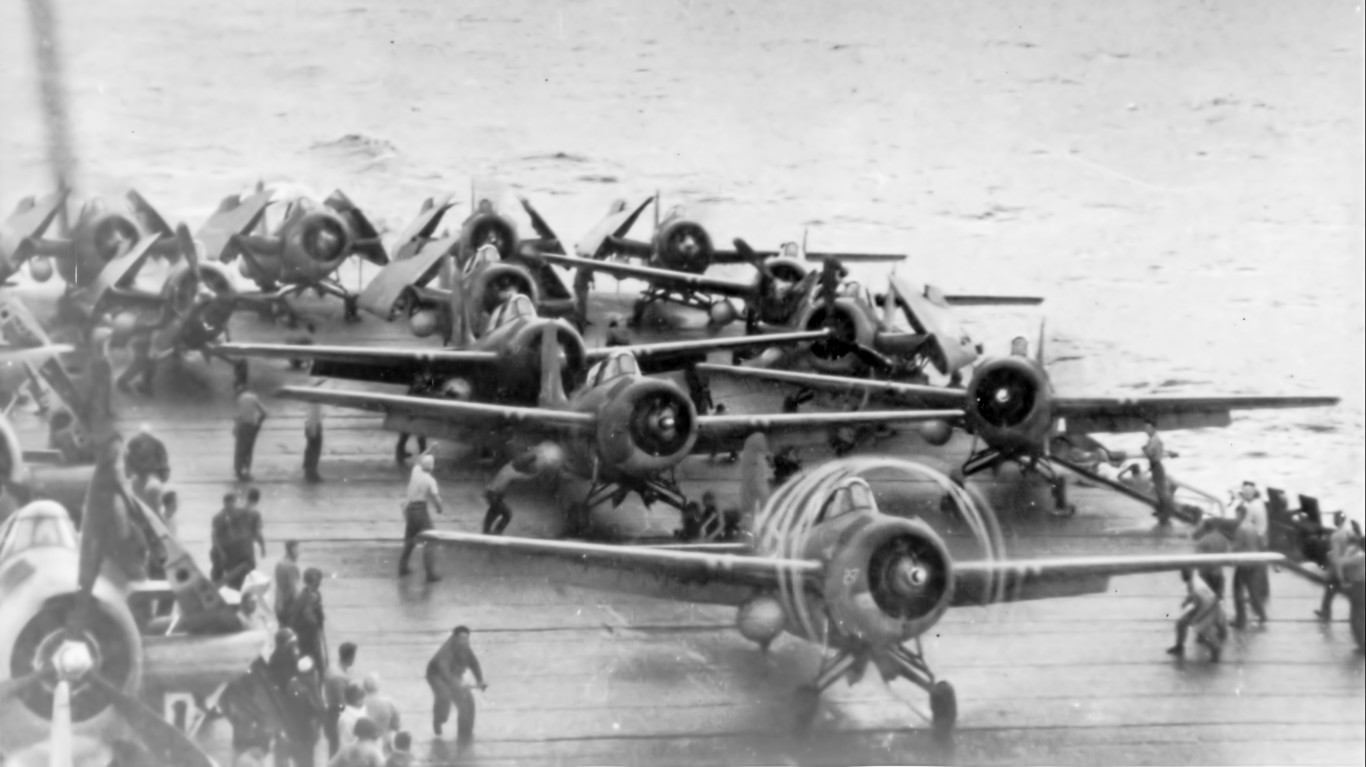
For millennia, naval battles have been some of the most important military conflicts. Controlling the seas gives the victors control of major ports and shipping routes, and the ability to encircle their opponents.
With such key strategic importance, military commanders throughout time have committed huge numbers of ships and troops to key naval battles. These conflicts are some of the most significant events in the history of war, turning the tide of some of the largest wars in human history.
To identify the largest naval battles in history, 24/7 Tempo used a variety of resources such as Encyclopedia Britannica to compile a list of naval military engagements that had the greatest number of participants and casualties as well as significant importance to world history.
Though many of these naval battles took place during the 20th century amid the World Wars, others happened centuries earlier. These ancient naval battles often shaped the course of world history, determining which empires rose and fell. Often, the casualty reports or troop counts for these battles may have been either exaggerated by the victors or lost to time.
Naval warfare can be especially tricky, as ships can be vulnerable to attacks from planes, submarines, land-based artillery, and other ships. One strike in the wrong place can sink an entire ship, jeopardizing the lives of the entire crew, and potentially pushing casualties into the thousands. These are the deadliest battles in U.S. history.
Click here to see the most pivotal naval battles of all time
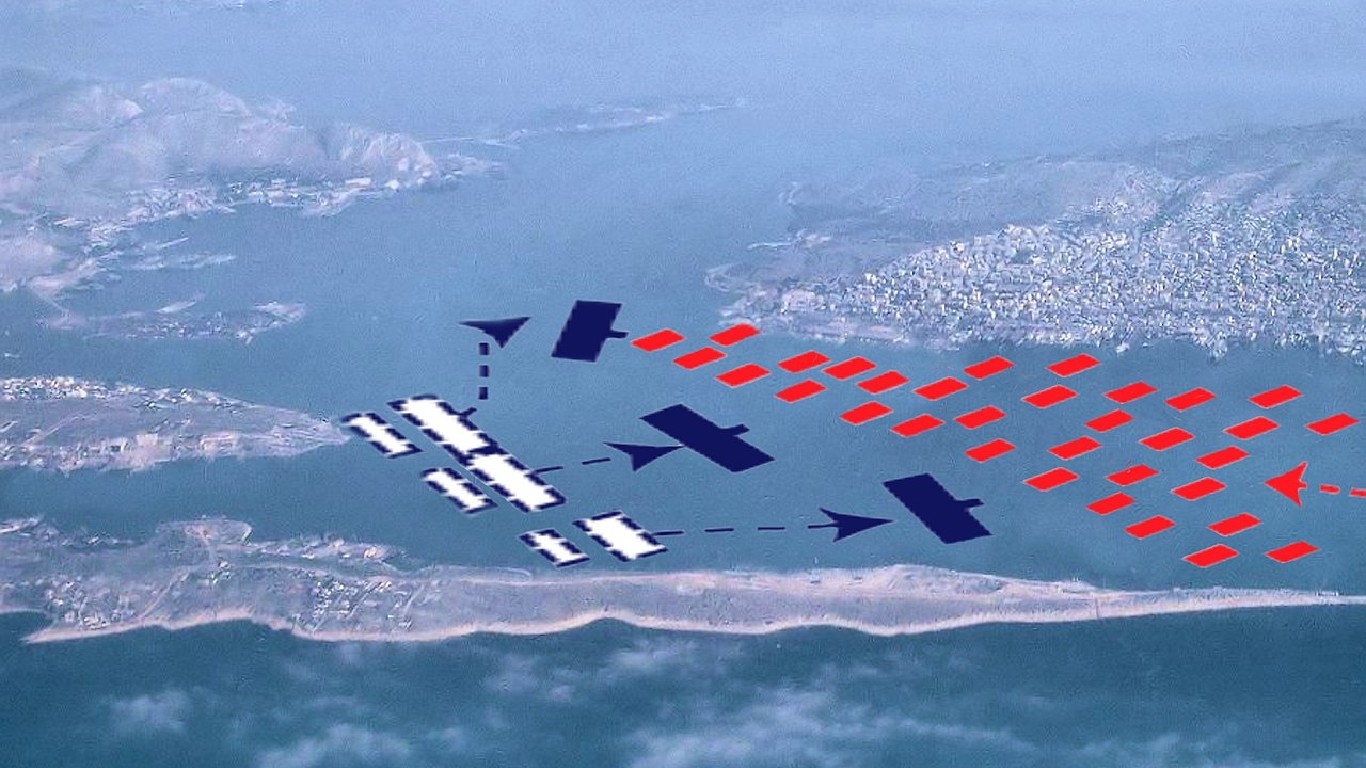
1. The Battle of Salamis, Sept. 26-27, 480 B.C.
> Casualties: 300 ships lost for the Persians, 40 lost for the Greeks
> Location: Saronic Gulf, Greece
> Conflict: Persian invasion of Greece
The Battle of Salamis is sometimes known as the first great naval battle in history. The Persian Empire had overtaken much of Greece by 480 B.C. after about a decade of fighting. Persian King Xerxes apparently hoped to finish off the badly outnumbered Greek fleet when he launched his ships into the strait between the island of Salamis and the city of Piraeus.
The history of this battle is murky, but according to many ancient sources, the large, tightly bunched Persian ships struggled to maneuver in the strait, while smaller Greek boats could ram and sink their opponents. The Persians lost hundreds of ships, compared to dozens of losses from the Greeks. The stinging defeat scattered the Persian ships, giving Greek troops time to reorganize. The next year, Greek forces defeated the Persians at Plataea, finally ending all conquest attempts and allowing Greece to flourish as one of the great world powers of history.
[in-text-ad]

2. The Battle of Red Cliffs, Winter, 208-209
> Casualties: Unknown, 850,000 estimated troops involved
> Location: Yangtze River, China
> Conflict: Cao Cao invasion of Southern China
Early in the third century, a warlord named Cao Cao took over the north of China after poor leadership from the Han Dynasty’s emperors led to a power vacuum. In the year 208, he turned his attention south, hoping to conquer the land south of the Yangtze River and unify China. Southern allies Liu Bei and Sun Quan partnered to fend off Cao Cao, though they were still badly outnumbered – 800,000 to 50,000 by some estimates.
The two sides met at the Battle of Red Cliffs at the port city of Jiangling on the Yangtze River. Cao Cao’s troops won the first skirmish with southern forces and received word a southern general wanted to defect. In actuality, the general sent a boat full of flammable materials careening into the tightly-packed northern fleet, setting it ablaze. Cao Cao retreated to rule the north, leaving Lui Bei and Sun Quan to control southern China. The Battle of Red Cliffs spelled the end of the Han Dynasty and determined how China would be divided among the three rulers during the Three Kingdoms period.

3. The Battle of Yamen, March 19, 1279
> Casualties: 100,000 Chinese casualties, a few thousand casualties for the Yuan Mongols
> Location: Yamen, South China Sea
> Conflict: Mongol invasion of China
The Mongol empire and the Song Dynasty partnered up to overthrow China’s Jin Dynasty in 1234. Shortly after, however, they became enemies, when the Mongols invaded in the hopes of taking over the country. The Mongols, buoyed by consistent success on the battlefield, established the Yuan Dynasty in 1271.
The Mongols conquered much of China throughout the 1270s, taking the capital in 1276 and pushing the Song forces to Yamen in southern China. Song forces prepared for a final battle in 1279. Though the Mongols were outnumbered, their superior fighting skill quickly overwhelmed the Song fleet. Nearly 100,000 Song troops were killed in the battle, with relatively few Mongol deaths. When defeat was imminent, Emperor Bing leapt into the sea – ending the Song Dynasty and beginning the reign of the Yuan Dynasty.
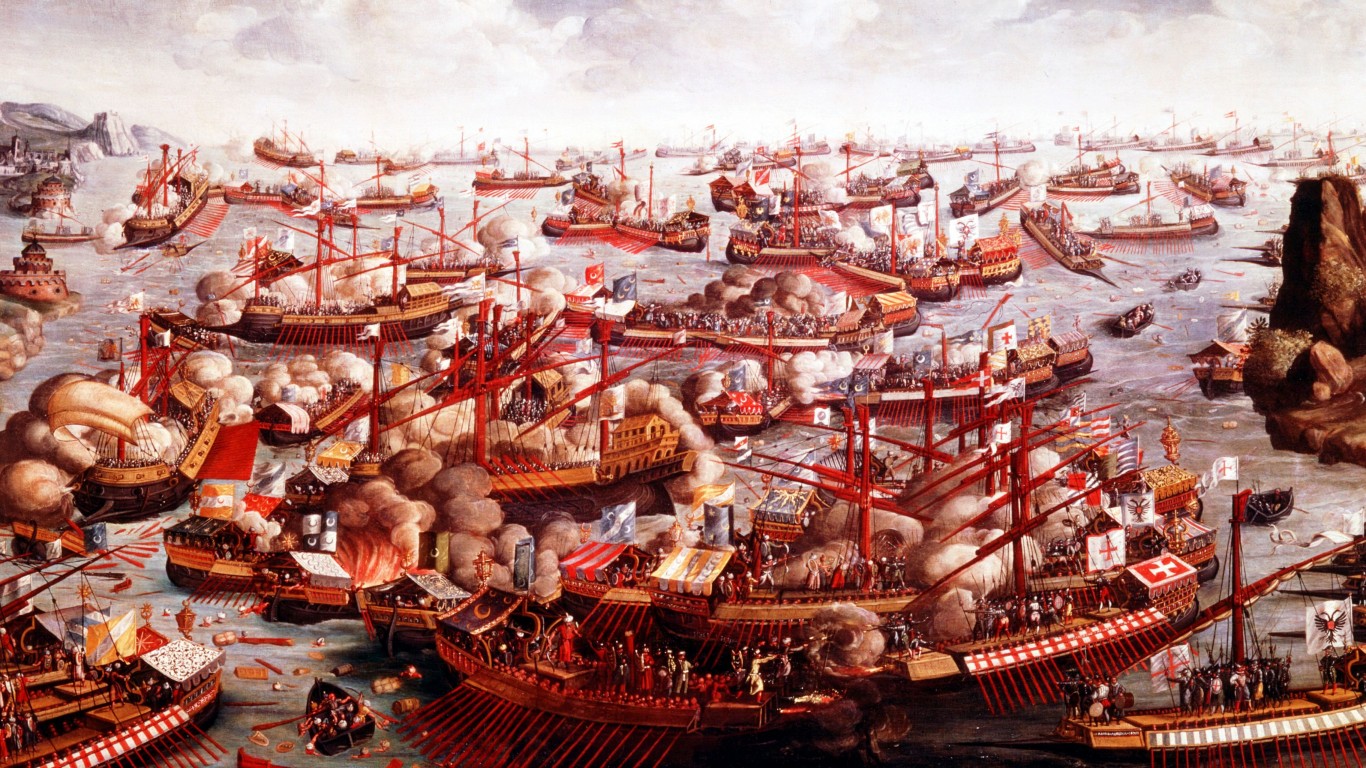
4. The Battle of Lepanto, Oct. 7, 1571
> Casualties: Around 8,000 casualties for each side
> Location: Gulf of Patras, Greece
> Conflict: Ottoman invasion of Cyprus
The Battle of Lepanto in 1571 marked a major turning point in the ongoing wars between the Ottoman Empire and allied fleets from Christian nations. The Ottomans expanded their land holdings into the Mediterranean throughout the 1500s, invading the Venetian outpost of Famagusta on the island of Cyprus.
The Venetians appealed to Pope Pius V for help from Christian nations, and he convinced Spain, Genoa, Malta, and others to enter the fray. The so-called Holy Fleet engaged the Ottoman Navy in the Gulf of Patras. After heavy fighting, the Ottomans were repelled, and some 15,000 Christian slaves were liberated. The battle marked the first time Christian forces were able to stop the Ottomans from advancing into the Mediterranean.
[in-text-ad-2]
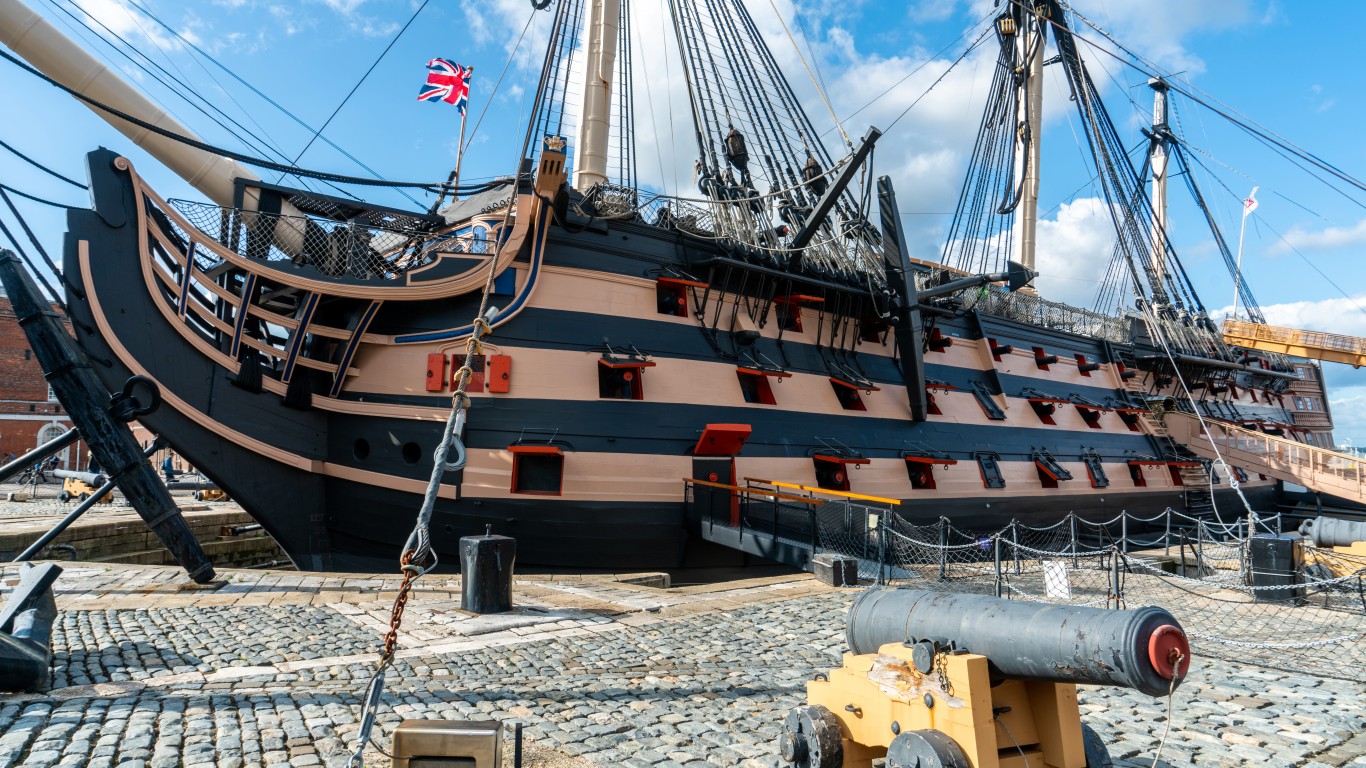
5. The Battle of Trafalgar, Oct. 21, 1805
> Casualties: 1,587 British casualties, 16,000 French and Spanish estimated killed or wounded
> Location: Cape Trafalgar, Spain
> Conflict: Napoleonic Wars
The Battle of Trafalgar in 1805 established the British Navy as the preeminent aquatic fighting force in the world. At this point, Napoleon Bonaparte and his forces had captured much of mainland Europe in the Napoleonic Wars and had tried to invade Britain the year before.
Napoleon’s combined French and Spanish fleet sailed from Cadiz in southern Spain to support Napoleon’s attempts to expand his empire east by taking Austria. The British, led by Admiral Horatio Nelson, attacked the Franco-Spanish fleet after it set sail to prevent any future attacks on Britain. Though the British were hobbled and outgunned, they split into two columns and attacked the front and the back. Nelson was killed in the fighting, but the British won a decisive victory, thwarting any further attempts by Napoleon to take Britain.

6. The Battle of Manila Bay, May 1, 1898
> Casualties: 77 dead, 200 injured for Spain. 1 casualty for the US
> Location: Manila Bay, Pacific Ocean
> Conflict: Spanish-American War
The Spanish-American War began in April of 1898. Americans largely supported war after seeing Spain wage war on Cubans who were pushing for independence. It became even more popular when the USS Maine was sunk under mysterious circumstances in Havana. Soon into the war, Commodore George Dewey was called to lead American ships into another Spanish colony – the Philippines.
Dewey and the Americans surprised the Spanish fleet on May 1, firing on the fleet and receiving little fire in return. By the end of the battle, all of Spain’s ships were destroyed, whereas American ships were largely unscathed. The victory ejected Spain from The Philippines, and the U.S. took control of the islands. Spain surrendered on July 17, 1898 – less than three months after the war started. The defeat ended Spain’s time as a colonial power and established the U.S. Navy as one of the world’s best.
[in-text-ad]
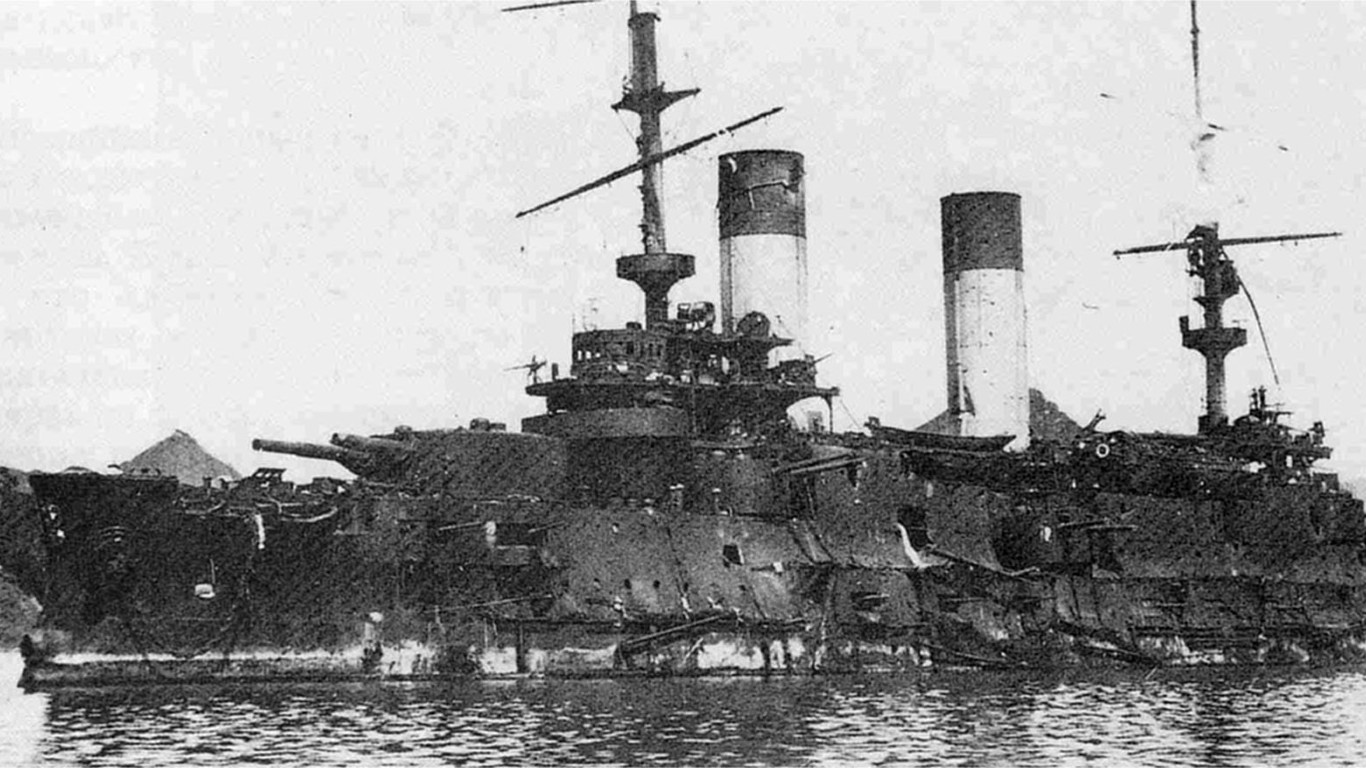
7. The Battle of Tsushima, May 27-28, 1905
> Casualties: 4,000 Russian sailors killed and 5,000 captured. 100 dead and 530 injured for Japan
> Location: Tsushima Strait, Japan
> Conflict: Russo-Japanese War
The Russo-Japanese War began after the two countries were unable to divide conquered areas of Korea and China between one another. Japan launched a surprise attack on a Russian naval base in China in 1904.
Russia counterattacked, launching its fleet towards the Tsushima Strait, a body of water in between mainland Korea and Japan. Russia badly underestimated the capabilities of the Japanese Navy and was quickly crushed. Of Russia’s 45 warships, just 10 survived the battle. Thousands of Russian sailors were killed, and Russia was forced to sign a peace treaty, ceding significant land to Japan in the area. As a result, Russia was no longer a dominant power in the region, while Japan expanded the reach of its empire.
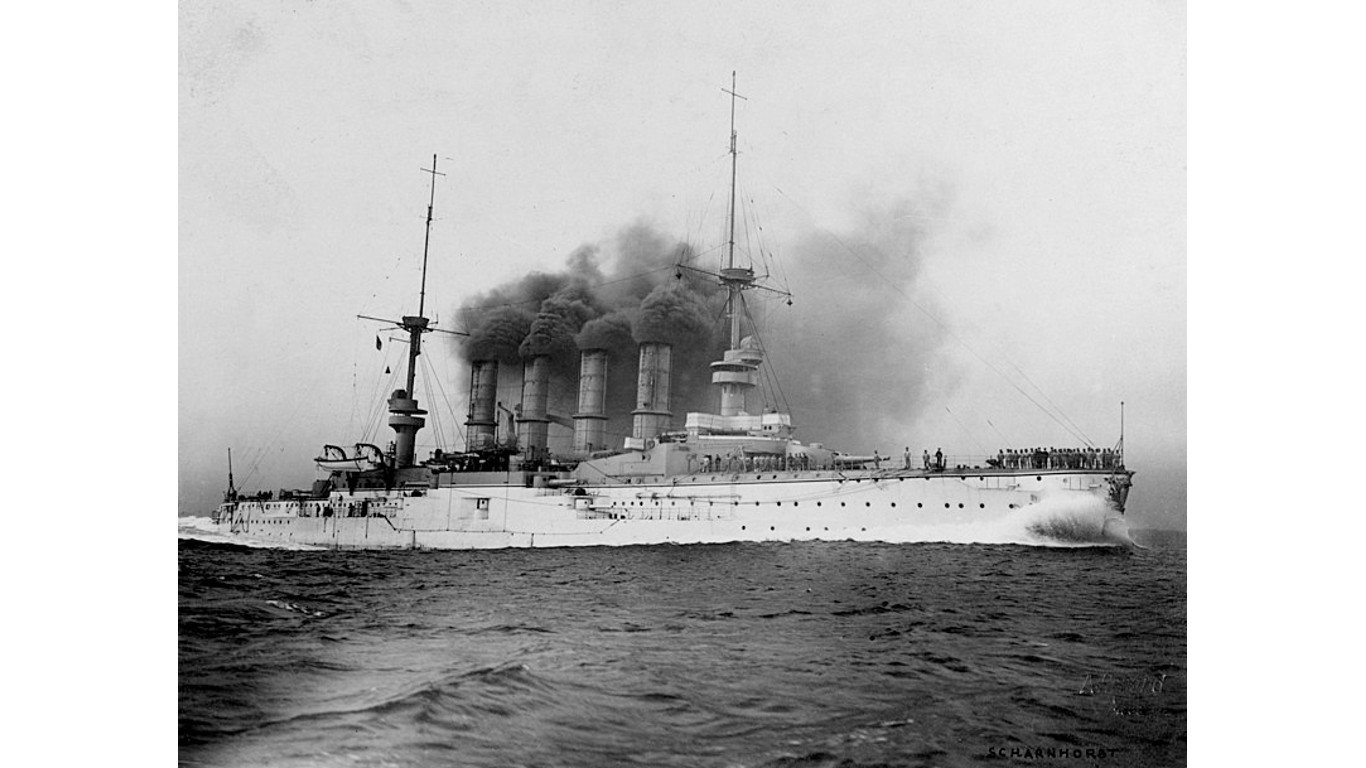
8. The Battle of Coronel, Nov. 1, 1914
> Casualties: Half of British ships sunk and 1,500 sailors killed. No casualties for von Spee and the Germans
> Location: Coronel, Pacific Ocean
> Conflict: World War I
One of the first major naval engagements of World War I, the Battle of Coronel was a disaster for the British Royal Navy. German Admiral Maximilian von Spee planned to disrupt British shipping routes from the west coast of South America, threatening supplies of weapons and food. British Admiral Craddock and his fleet were ordered to stop that from happening, though they were significantly outnumbered.
Craddock hoped to receive reinforcements, but reinforcements could not get to the Chilean coast in time. The British and German navies engaged one another off the coast of Coronel on Nov. 1, 1914. Two of the four British ships were sunk and the other two retreated, while German ships suffered little damage. The British public was shocked by the defeat – their worst naval loss in a century.
9. The Battle of Falkland Islands, Dec. 8, 1914
> Casualties: German fleet destroyed and 2,000 sailors killed. 10 killed and 14 wounded for British
> Location: Falkland Islands, Atlantic Ocean
> Conflict: World War I
After the defeat at Coronel, the British Navy wanted revenge and to regain their strategic footing near South America. A squadron led by two battle cruisers sailed for the southern tip of the continent. The ships were much more powerful than the ones that had previously been lost.
The squadron caught the Germans and Admiral von Spee by surprise near the Falkland Islands. The Germans tried to flee but were unable to escape and turned to fight the British ships. Hopelessly outgunned, the Germans lost nearly 2,000 sailors, while the British lost just 10. The victory at the Falkland Islands provided a significant morale boost for the British public, as their ground forces struggled on the Western Front of World War I.
[in-text-ad-2]

10. The Battle of Jutland, May 31-June 1, 1916
> Casualties: 6,000 killed and 600 wounded for British, 2,500 killed and 500 wounded for Germany
> Location: North Sea, Atlantic Ocean
> Conflict: World War I
> Casualties: 6,000 killed and 600 wounded for British, 2,500 killed and 500 wounded for Germany
> Location: North Sea, Atlantic Ocean
> Conflict: World War I
World War I’s largest naval battle took place in 1916 off the coast of Denmark in the Battle of Jutland. Prior to the battle, German cruisers bombarded English coastal cities to lure British ships into a confrontation, then sailed north where the rest of the German fleet lay in wait in the hopes of crippling the British fleet. However, British codebreakers learned of the plan, and readied their forces for the confrontation.
The two powers met on May 31, with over 200 ships and roughly 100,000 sailors involved in the fighting. The British struggled tactically, springing their trap too early for one of the squadrons to arrive in time for the beginning of the battle. Though the battle inflicted a heavy cost – the British lost 6,000 troops and 14 ships, compared to the Germans 2,500 sailors and 11 ships – it allowed the British Navy to maintain control over the North Sea and eventually implement its devastating blockade that would help defeat Germany.
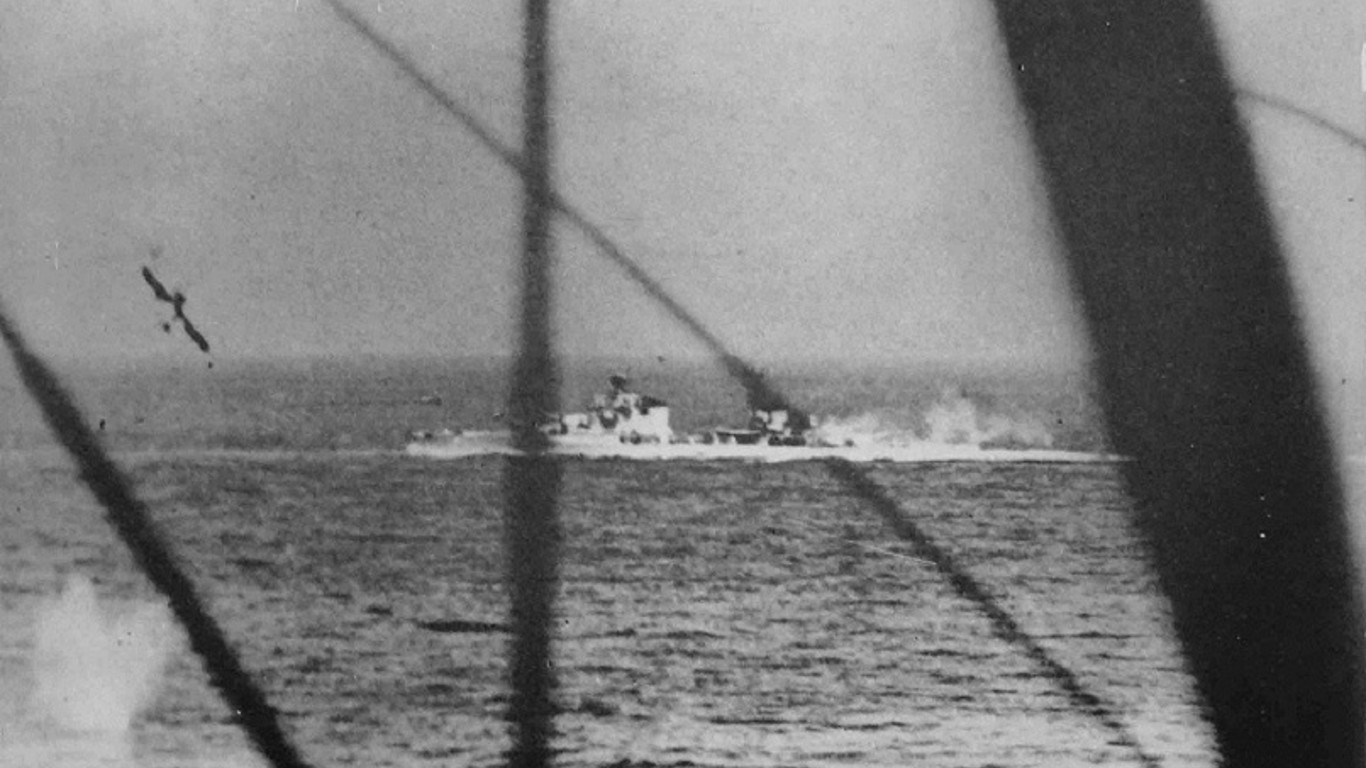
11. The Battle of Cape Matapan, March 27-29, 1941
> Casualties: 2,300 Italian sailors killed and 1,000 captured. 3 killed and 4 injured for the allies
> Location: Cape Matapan, Greece
> Conflict: World War II
In 1941, the Mediterranean Sea was a hotly contested area between the British and Italians, as they jockeyed for key positions during World War II. The Germans wanted Italian support in the area as they pushed ground forces into Greece, so the Italian Navy planned to attack allied convoys off of the Greek island of Crete. However, the British had shortly before unencrypted their communications, giving the British Navy advanced warning of the attack.
The Italians incorrectly thought the British battleships were disabled and prepared for a battle. Not only did the British have more naval power than the Italians, but they also had significant air cover thanks to planes launched from Crete. The Italians were decimated, losing over 2,000 sailors and five ships. Only three British troops were killed, and the allies maintained control over the Mediterranean.
[in-text-ad]
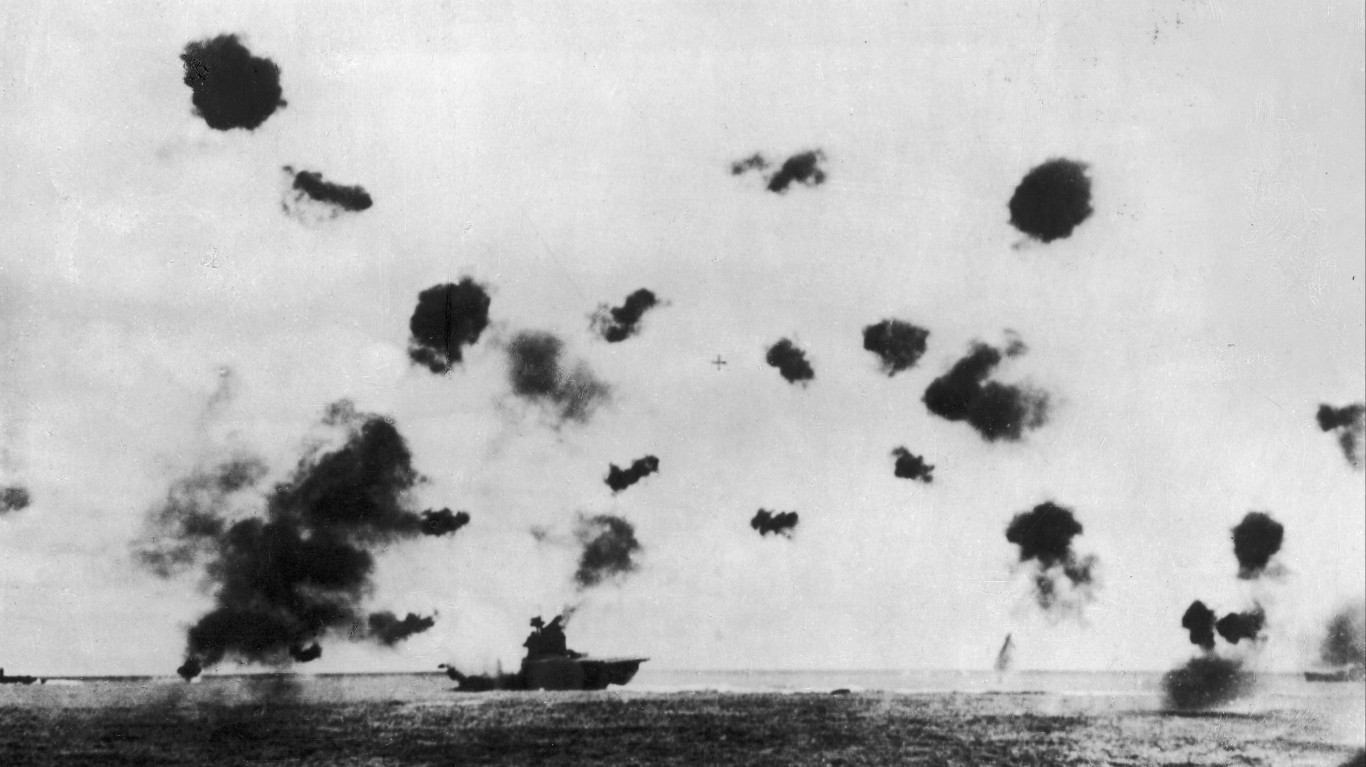
12. The Battle of Midway, June 3-6, 1942
> Casualties: 3,000 Japanese casualties, 317 US casualties
> Location: Midway Atoll, Pacific Ocean
> Conflict: World War II
Shortly after Japan’s attack on Pearl Harbor, the U.S. entered World War II. Japanese commanders hoped to control the Pacific by overtaking an allied base in the Midway Atoll, just northwest of Hawaii. Unbeknownst to them, U.S. codebreakers had access to their communications and knew the attack was coming.
Japanese planes attacked and damaged the base on June 4. After the attacks, they flew back to their aircraft carriers to refuel. U.S. ships and planes were waiting just off the island and launched a surprise counter. The plan worked well, and the U.S. Navy wiped out much of Japan’s fleet over the next few days. Japan lost over 3,000 soldiers in addition to four aircraft carriers and hundreds of planes. U.S. casualties were much lower, and the victory allowed American forces to halt Japanese expansion into the Pacific and gain a foothold in the area.

13. The Battle of the Coral Sea, May 4-8, 1942
> Casualties: 600 allied casualties, 900 Japanese servicemen killed
> Location: Coral Sea, New Guinea
> Conflict: World War II
In May 1942, Japan was trying to expand its territory, pushing towards Australia and occupying territory in the Solomon Islands. They next planned to take control of Port Moresby in New Guinea, but the Allies were prepared for the attack thanks to their codebreakers.
The Battle of the Coral Sea featured four days of heavy fighting between Japanese and American planes. The battle is sometimes known as the first modern naval battle, as ships from both sides never fired on one another, leaving the fighting to planes. Both sides lost dozens of planes and hundreds of troops, but Japan won control of the Solomon Islands. However, the fighting was so fierce and the losses so great that they were unable to extend their control any further into the Pacific.
14. The Battle of the Philippine Sea, June 19-20, 1944
> Casualties: 2,000 Japanese sailors killed and 395 planes destroyed. 100 US casualties and 130 aircraft destroyed
> Location: Philippine Sea, Pacific Ocean
> Conflict: World War II
In World War II, the U.S. Navy fought Japan through a strategy of “island hopping” by taking strategic Japanese-held islands closer and closer to the Japanese mainland. In June of 1944, the Americans sought to invade the island of Saipan in the Philippine Sea.
Japan sent four waves of air raids to try to repel American forces, but the inexperienced pilots stood little chance. An estimated 315 of the 423 Japanese planes involved were shot down, allowing the U.S. to sink three aircraft carriers in the course of battle.
[in-text-ad-2]
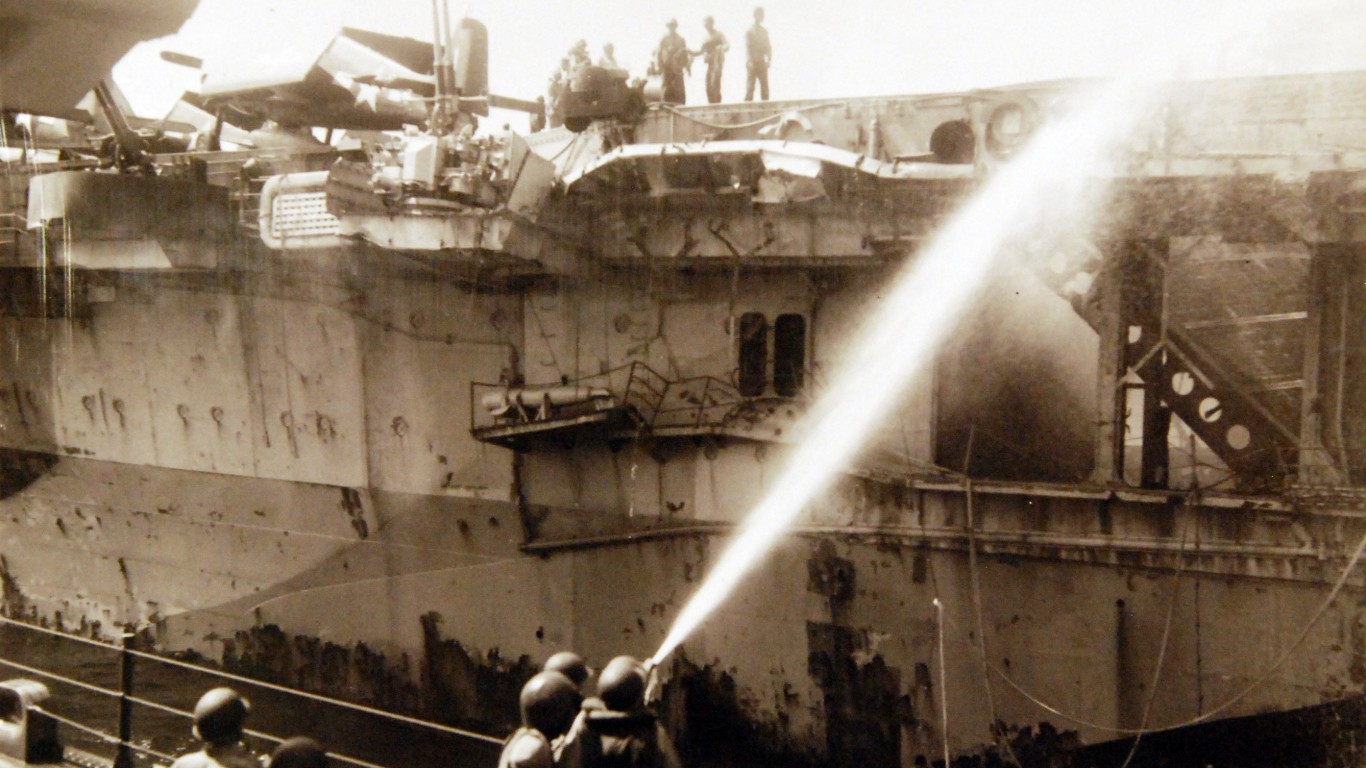
15. The Battle of Leyte Gulf, Oct. 23-26, 1944
> Casualties: 10,000 Japanese sailors killed and all carriers destroyed. 3,000 US sailors killed and six ships destroyed
> Location: Leyte Gulf, Pacific Ocean
> Conflict: World War II
The Battle of Leyte Gulf in the Philippines is considered by some to be the largest naval battle in history. The U.S. Navy pushed further into the Pacific, hoping to cut off Japanese supply lines from Southeast Asia and hold strategic points close enough to Japan to launch attacks on the mainland.
Already reeling, Japan’s Navy collected much of its remaining ships together to repel the U.S. invasion into the Philippines. As the U.S. forces approached, Japan drew the different fleets into a number of separate engagements all across the region. All in all, over 300 ships and more than 400 planes did battle. The U.S. inflicted massive casualties on Japan and sunk 26 warships, including four aircraft carriers. The loss at Leyte Gulf dealt a death blow to Japan’s ambitions, crippling their navy and giving the U.S. undisputed command of the Pacific.
The Average American Is Losing Their Savings Every Day (Sponsor)
If you’re like many Americans and keep your money ‘safe’ in a checking or savings account, think again. The average yield on a savings account is a paltry .4% today, and inflation is much higher. Checking accounts are even worse.
Every day you don’t move to a high-yield savings account that beats inflation, you lose more and more value.
But there is good news. To win qualified customers, some accounts are paying 9-10x this national average. That’s an incredible way to keep your money safe, and get paid at the same time. Our top pick for high yield savings accounts includes other one time cash bonuses, and is FDIC insured.
Click here to see how much more you could be earning on your savings today. It takes just a few minutes and your money could be working for you.
Thank you for reading! Have some feedback for us?
Contact the 24/7 Wall St. editorial team.
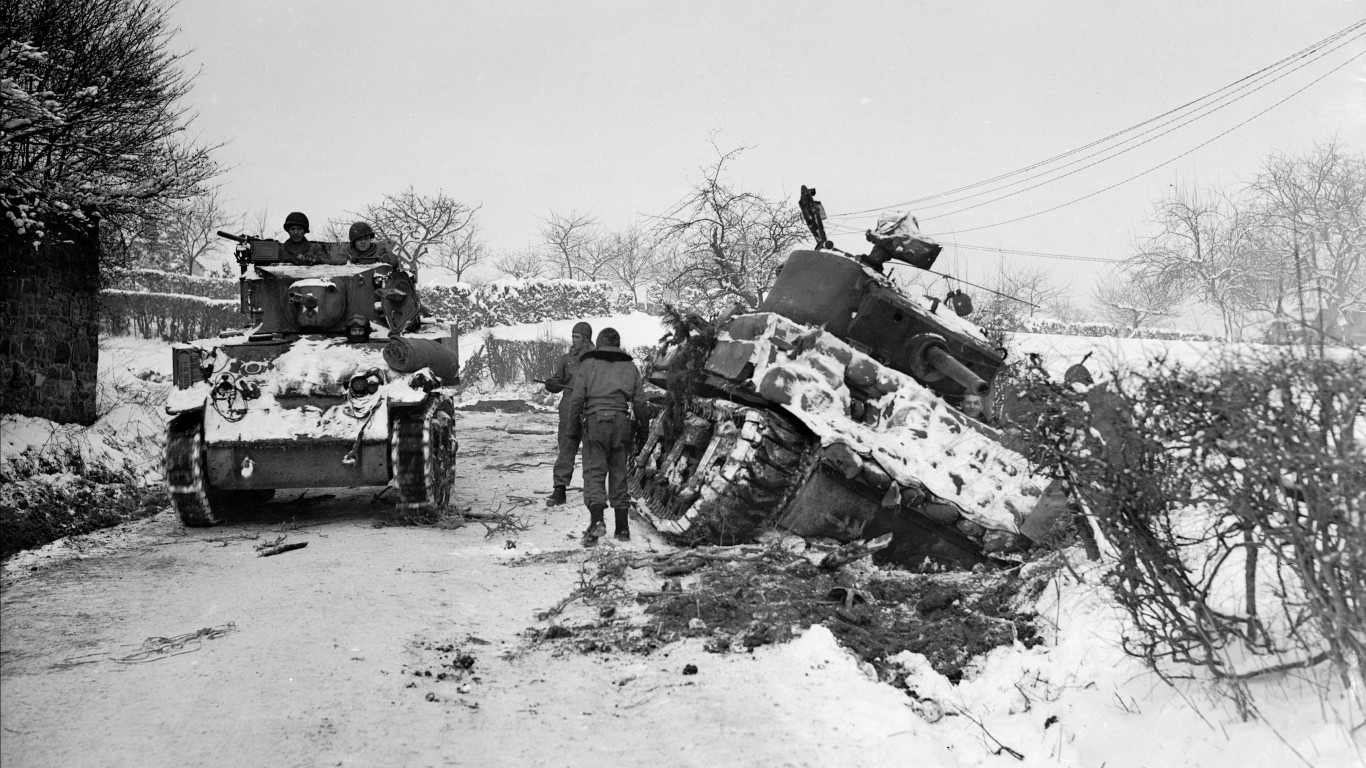 24/7 Wall St.
24/7 Wall St.
